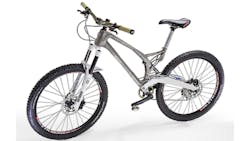Customized Titanium Cycle Frame... Redesigned, Printed and Assembled
Renishaw is known for producing high-precision metrology and motion control products, but its wholesale investment into direct metal laser sintering three years ago extends that expertise with precision products into one of the most dynamic industrial realms — additive manufacturing. Now. Renishaw has collaborated with a British bicycle designer to to create the world’s first 3D-printed metal bike frame.
Empire Cycles designed the mountain bike for lightness and durability, using a process called “topological optimization.” It deployed Renishaw’s AM250 additive manufacturing system to produce the individual parts, and giving it a new range of design possibilities.
Additive manufacturing offers design, construction, and performance advantages that include blending complex shapes or hollow structures with internal strengthening features; flexibility to make design improvements right up to the start of production; and the convenience of making single parts as easily as batches, which means a high degree of design customization.
The new titanium alloy frame for the mountain bike — reportedly about 33% lighter than the original design — was produced in individual pieces that were later bonded together.
Originally, the partners’ plan was to optimize the design of and manufacture only the bike’s seat post bracket; after the part’s successful production, improving the whole frame became the new goal.
Empire started with a full-size 3D printed replica of its current aluminum alloy bike, and the frame was sectioned into parts that could be formed in the AM250’s 12-in. (300-mm) high build envelope. The design was updated with data supplied by Renishaw’s applications team, and an optimized design was created using topological optimization – it eliminated many of the downward facing surfaces that require unwanted support structures.
Topological Optimization
Topological optimization software programs use iterative steps and finite element analysis to determine the “logical” material placement. Material is removed from areas of low stress until a design is created that’s optimized for load bearing. The result is a model that is light and strong. Historical challenges in manufacturing these computer-generated shapes are overcome through the additive manufacturing process.
The AM250 processes CAD-derived data and uses a fiber laser working in a controlled atmosphere to convert layer upon layer of metal powder, in thicknesses from 20 to 100 microns, into fully dense metal parts.
Notably, the vacuum chamber and ultra-low oxygen content in the build atmosphere make it possible to produce parts in reactive materials, including titanium and aluminum.
Empire Cycles finds performance advantages by employing additive manufacturing. Its new design has all of the advantages of a pressed steel monocoque construction used in motorbikes and cars, but with no investment in tooling — which would be cost-prohibitive for small manufacturer and significantly reduce options for customizing or modifying the design.
“As no tooling is required, continual design improvements can be made easily, and as the component cost is based on volume and not complexity, some very light parts will be possible at minimal costs,” said Dave Bozich, Renishaw business manager.
Making It Light
The original aluminum alloy seat post bracket weighs 12 oz. (360 g) and the first iteration of the hollow titanium version is 7 oz. (200 g), a weight savings of 44%. Comparing the entire frames of the original and optimized designs, the original bike frame weighs 4.6 lbs. (2,100 g); the redesigned frame produced by additive manufacturing weighs 3.1 lbs. (1,400 g), a savings of 33% in weight.
“There are lighter carbon-fiber bikes available, but the durability of carbon fiber can’t compare to a metal bike,” according to Empire Cycles managing director Chris Williams.
“They are great for road bikes, but when you start chucking yourself down a mountain you risk damaging the frame,” Williams noted. “We over-engineer our bikes to ensure there are no warranty claims.”
Titanium alloys have more density than aluminum alloys, with relative densities of around 0.14 lb/in3 (4 g/cm3) and 0.11 lb/in3 (3 g/cm3), respectively. Therefore, the only way to make a titanium alloy part lighter than its aluminum alloy counterpart is to significantly alter the design and remove any material not contributing to the overall strength of the part.
Empire Cycles and Renishaw believe further analysis and testing could result in further weight reduction.
In addition to durability and corrosion-resistance, titanium alloys have a high Ultimate Tensile Strength (UTS) of more than 900 MPa, when processed using additive manufacturing. With near-perfect densities – greater than 99.7%– the process is better than casting, and the small, spherical nature of additive-part porosity has little negative effect on strength. The seat post bracket was tested using the mountain bike standard EN 14766, and it withstood 50,000 cycles of 270 lb.f.t (1200 N). Testing continued to six times the standard without failure.
“We plan to develop this further, in partnership, to look at iterative improvements in bonding methods, such as specific surface finishes,” said Bozich. “This project demonstrates that excellent results can be achieved through close customer collaboration.”
About the Author
Robert Brooks
Content Director
Robert Brooks has been a business-to-business reporter, writer, editor, and columnist for more than 20 years, specializing in the primary metal and basic manufacturing industries.
